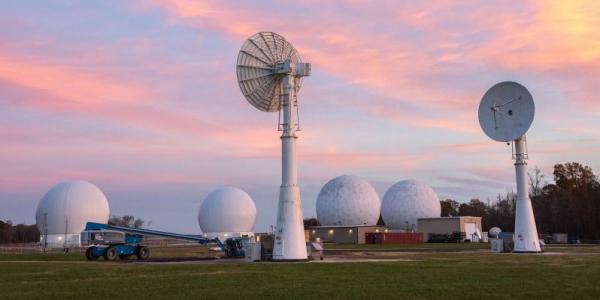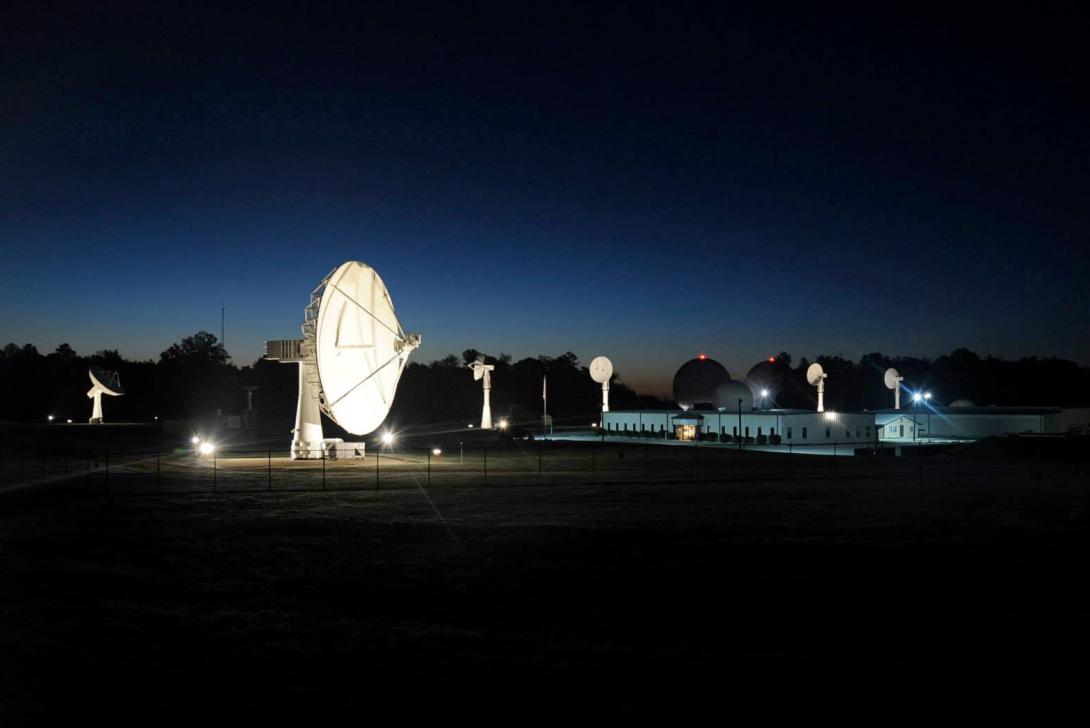NRL Extends Autonomous Satellite Tracking Ability
By year’s end, U.S. Navy researchers intend to add one of two remote autonomous antennas to its satellite tracking architecture, enhancing its ability to collect strategic satellite data and support space-related research and development.
The first antenna will be located at a secure, undisclosed and unmanned site in California and will extend the tracking capabilities from Blossom Point, Maryland. The second is planned for Hawaii.
Blossom Point is located south of Washington, D.C., and is owned and operated by the Naval Research Laboratory (NRL). It is considered a state-of-the-art command and control facility capable of supporting satellite spaceflight missions from launch through end-of-life.
The facility provides command, control, communications, network engineering, and management of new and on-orbit assets. Blossom Point supports spacecraft operations in all orbits and complements and supports the NRL’s skills in space systems by providing compatibility testing, pre-launch, launch, and post-launch support, flight operations, and mission data processing, according to an NRL fact sheet.
The facility supports an advanced suite of ground equipment in a resource pool that includes antennas, front-end processors, command encoder units, receivers, amplifiers and all of the other equipment necessary to perform satellite command and control functions in a secure environment.
The systems there are fully automated, reducing manpower and costs. The foundation for this broad range of capabilities is the NRL-developed and government-owned Neptune software system, according to an NRL website. The NRL has optimized the hardware and software architectures over many years to maximize flexibility in integrating new spacecraft programs and ground systems while minimizing manning requirements and costs.
Blossom Point produces high-level military mission data. “We support the strategic layer where we provide lots of information in a much less expensive but more robust manner,” says Robert Ritter, an NRL system engineer supporting the antenna expansion.
But for military purposes, they see a high demand for weather data. “One of the really important elements of data that we gather from Blossom Point to mission is weather. Being able to get weather over areas without coverage that a weather station doesn’t necessarily have but the spacecraft has, being able to get that data more quickly, more reliably, out to the field is very beneficial for the military,” adds Andrew Cox, who heads NRL’s Satellite and Communications section.
The site also supports experimentation and space-related research and development for the military services, the Defense Advanced Research Projects Agency (DARPA) and others. They turn to Blossom Point because “we’re good at it, because we’re efficient, and it saves them money for these research and development satellites that they have,” Cox offers.
Now Blossom Point’s capabilities will be extended with the remote antennas in California and ultimately Hawaii as well. “Obviously, coverage of a spacecraft on the ground is not always consistent. Extending that ground coverage gives us quicker access to data from ground to a spacecraft by having more deployments of ground assets,” Ritter says.
The Blossom Point location was originally chosen because it was remote enough not to receive a lot of electrical interference, but having multiple sites offers additional advantages, Cox notes. “A number of years ago, we worked with the Pentagon, which funded us to extend our architecture to California and Hawaii, to locations where we can expand the footprint of the parts of the Earth that we can cover in a more real-time fashion.” That funding began in 2017, he clarifies.
The California site has been undergoing final testing, but officials couldn’t predict exactly when that testing might be completed. “If COVID wouldn’t have happened, it would have been done right now. It’s really, really close right now,” Cox says. “It’s just that we need time for the engineers to go in and actually test the whole architecture from end to end. And right now, it’s just limited conditions with the COVID-19 virus—limited by the number of people we can have on-site and what we can actually do with fewer people at one time.”
Asked if it might be completed by August, Cox suggests it’s possible. “There is a chance. There might be a really good chance. Either way, it should be this year,” he adds. L-3 Harris Communications Systems West is the prime contractor on the extension effort.
The final testing includes live satellite contact with the remote site acting as a relay station. During the contact, officials will transmit information to the satellite and download mission data from the satellite. That information will then be processed at Blossom Point, now referred to as the hub site.
Live contact during final testing also will include checking the health of the spacecraft. “A satellite will pass overhead, and we will be able to communicate with the satellite and get the status and health—what the battery level looks like, how the satellite’s doing, whether it’s reporting any anomalies or errors. It could be overheating, could be underheating, it could be any number of things,” Cox explains.
He emphasizes the importance of automation. “We can do all the testing we want without anybody being out there. Nobody has to be there to do anything because we can do whatever we want from Blossom Point.”
The schedule for the Hawaii site is a little less certain. The design is 95 percent complete, Cox reports, but the effort “hit a little bit of a roadblock because the funding for that one kind of fell apart recently.”
The NRL has, however, fielded a temporary antenna and is delivering racks of associated computer equipment, so the site should be operational to some degree this month. “The permanent antenna is on order and will be done in January. We just have no concrete to put it on yet. The temporary antenna will be operational with limited operations until we find the funding and finish that part of the work,” Cox indicates.
While antennas at both extension sites will be fixed, the NRL officials allow, when asked, that it is technically feasible to place antennas on a mobile platform. “There is absolutely nothing preventing that,” Cox acknowledges.
The officials tout the automation capabilities at both the Blossom Point hub site and the Pacific region extension. “They’re completely autonomous remote facilities. The only time you visit them is to do maintenance, either for preventive maintenance or upgrades or whatever you may want to do. But there is no requirement to have people located at both sites,” Cox states.
However, human intervention is possible. Typically, that is only done if a satellite is having issues, which is rare. “People can sit at a keyboard at Blossom Point, disable the automation on the software with one click of a button, and then when you do that, you’d better have a person sitting there and getting ready to do something with the satellite because now you’ve stopped the automation,” Cox points out.
Even in times of trouble, automation often is preferable. “Having an automated system can help recover the spacecraft easier and faster than a person sitting in a seat,” Cox adds.
Whether operations are automatic or manual, ground networks play a critical role in connecting the remote sites to Blossom Point, Ritter explains. “We have to condition the equipment that’s remote and the communication link between that equipment so that we can transport data reliably across these ground networks,” he offers. “Ground networks, even though they seem like they’re really, really good … get spotty sometimes.”
And when the connections get spotty, synchronization is key. “It’s a matter of getting everything very tightly synchronized between the assets. We’re able to deploy equipment that does that synchronization so that we have reliable, error-free synchronous communications between Blossom Point and those remote stations. That allows us to have a variety of data rates, of mission data, and health and status data go across this network extremely reliably,” Ritter elaborates.
The extension antennas are satellite agnostic, meaning they will work with any kind of satellite in any orbit, Cox points out. “The remote antennas are universal. They’re not dedicated to any particular mission. You could do one mission for the Air Force, and 20 minutes later, you do one for the Army or DARPA or NASA or whoever. They are not at all hard coded to a particular satellite or agency.”






Comments